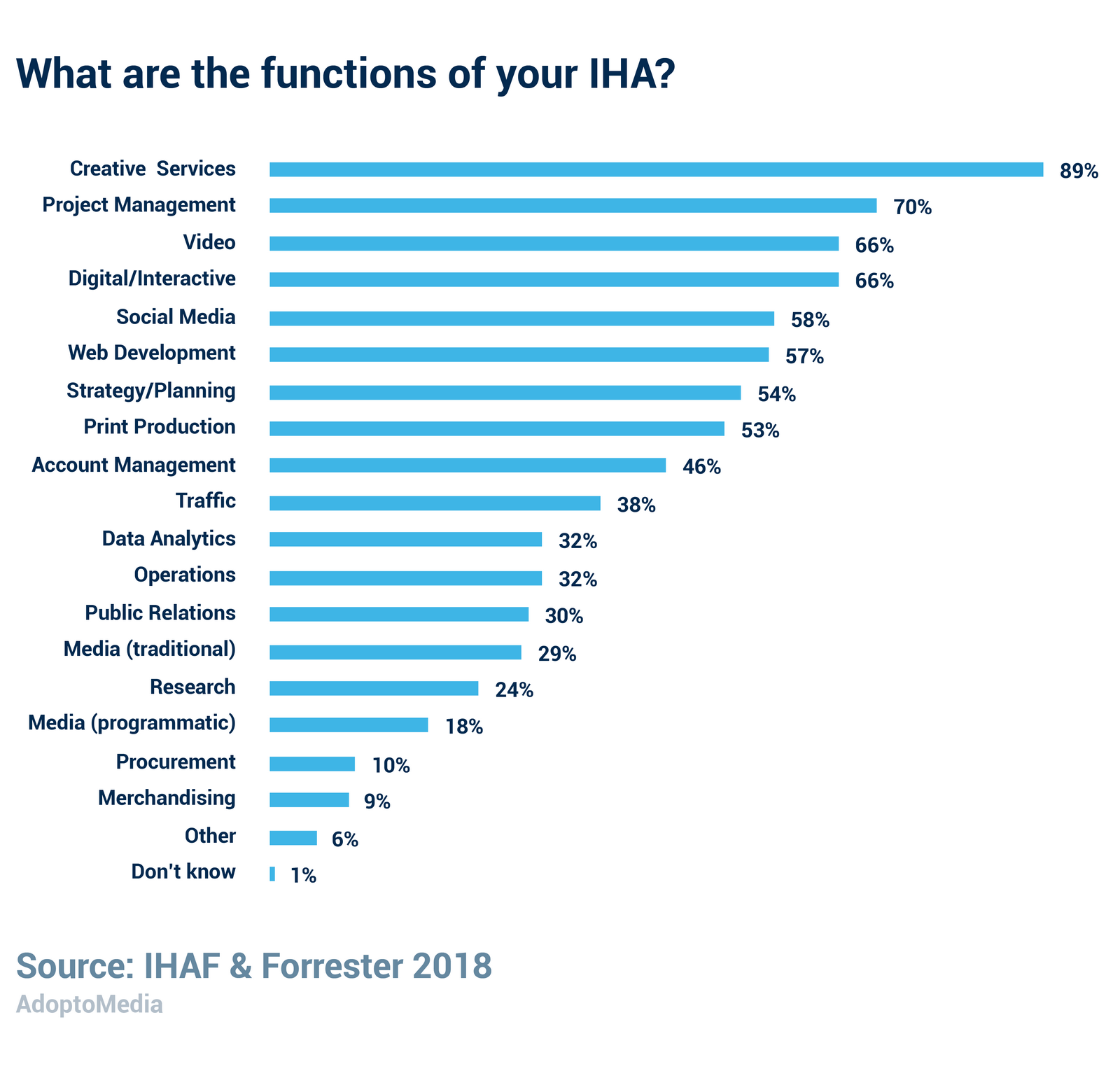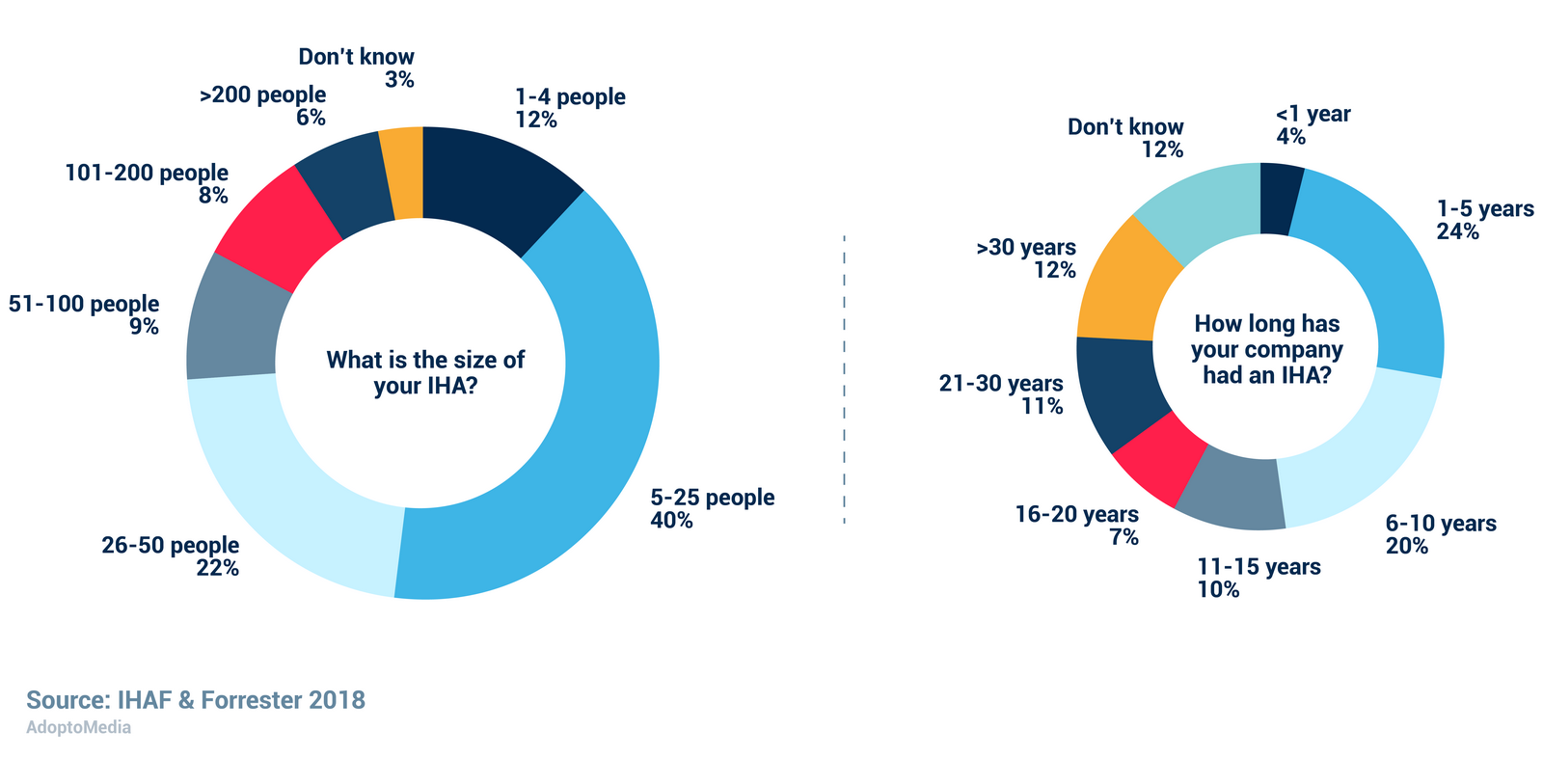
According to a joint research by In-House Agency Forum and Forrester, 64% of American corporations had an in-house agency in 2018 compared to 42% in 2008. The trend is becoming a reality even though it’s costly and challenging. In this article we investigate the benefits of building internal capabilities, functions better managed internally and ways to deal with widespread concerns and obstacles.
It is quite obvious that large brands like Procter & Gamble, Ally Financial and Clorox wouldn’t set up internal marketing teams if it was useless. For example, P&G established its own agency in 2018 as a part of their new marketing strategy saving $750 mln. Apart from cost efficiency in-housing is also driven by the opportunity to gain greater brand insights, increase transparency and control over the creative. Another advantage of IHAs is they have the same goal with the brand and are more invested in successful outcome, which is not always the case with outside agencies. Sometimes they have conflicting interests and focus not on promoting the advertiser but on promoting themselves. It’s definitely not always the case, but happens occasionally. In-house teams better understand the business, know more about your products or services. They are insiders who have the capacity to influence strategies on a level impossible for external agencies. If it wasn't for bureaucracy and decision-making hierarchies, IHAs would be able to fully realize their potential. Further are a few areas where in-house capabilities come in handy:
-
Customer data management: 38% of respondents in Digiday research gave it as the reason for in-housing. It’s easier to collect and use data with internal resources and comply with all the legal requirements affecting data availability like GDPR and CCPA. It allows organizations to know what ads are shown and when, better understand interaction with clients at every touch point, create more personalized ads and choose the most relevant next offer. P&G created a database of 1.5 mln consumers, which helped them to adjust ad frequency and save money. Customer data platform helps to manage it easily. Some brands generate free useful content in exchange for first-party data. Successful implementation of this strategy requires advanced content-creating skills.
-
Creative for social channels: they require increasing amount of content, so it makes sense to handle this task internally, while outsourcing bigger projects and ideas, because in-house teams create such content faster. P&G chief brand officer, Marc Pritchard, said that it takes them 10 times less money and 5 times less time when they make creatives themselves.
-
Digital: as it involves work with real-time insights and requires quick decisions and actions, this aspect should be handled by internal personnel. Faster and easier communication with IHAs creates favourable conditions for addressing this task in the most effective way.
-
Video-production: with video content becoming one of recent internet marketing trends, it’s getting more difficult for agencies to produce enough of it in a short time. In-house teams generate such content much faster and cheaper.
In the bar graph below you can see other functions that are often performed by IHAs.

On the other hand, there are some problems and concerns with setting up an effective internal team. Maintaining an in-house agency when you already have one is not a less challenging process. Researches show that IHAs are going through some kind of a crisis right now. As for many companies it’s a relatively new experience, they are still learning to handle arising situations. Further we analyze common issues and possible solutions.
According to a recent ANA and Boston Consulting Group survey, two most often mentioned problems are keeping in-house team motivated and energized (63%) and talent hiring and retaining (44%).
-
Forming a professional team is a really difficult task, especially in such areas as marketing mix modelling, reporting and billing, and there are two ways to solve it. You can dedicate a lot of resources to offering potential candidates a high salary, a good retirement plan, optimal work-life balance, organizing training workshops for the staff, giving them projects for different company brands and various challenging tasks. And there is an easier way: to combine advanced automation tools for daily operations with outstaffed personnel from external agency-partners. There is no need to focus on creating a full-fledged in-house team, because from a financial point of view, attracting talents for an in-house agency is not cost-effective, especially for small companies. For the same amount money you can either hire one top expert or get the skills and experience of 10 external specialists. Moreover, in-house agencies will be seriously affected by turnover because the amount of resources spent on finding and training every employee makes each of them almost irreplaceable. That is why automation combined with outstaffing is the most practical solution.
-
Another 37% of respondents voiced concerns about maintaining key marketing processes, because many companies fail to act rigorously enough during briefings or when giving feedback to internal teams. As a result, they cannot successfully carry out set tasks. 54% of corporate marketers are not so strict and controlling with in-house teams as with external agencies at the stage of planning and starting projects, nevertheless they apply the same standards to measure the output of IHAs and other agencies, controlling it quite strongly, which is a clear mismatch. It’s crucial to find the right balance between autonomy and control to ensure your employees are doing what you need without stifling the creative process.
-
Equipping the internal team with necessary marketing tools and technology is costly, even though it saves some money on agency fees, so only big brands can afford it. Procter & Gamble has in-housed 30% of its media buying. Another successful example is Ally Financial, became 25% more efficient after in-housing programmatic media buying.
-
According to IHAF and Forrester research of about 370 companies, 52% of IHAs believe that they don’t get enough financing. Sometimes brands don’t even understand how much they need to spend to get good results. Companies should invest more in staff, training, media capabilities, project management, technology, workspace and culture. Now they have to rely on external sources to make up for the lack of mentioned above. Namely, 82% of IHAs turn to them when they cannot cope with the amount of work or don't have the necessary capabilities for some tasks. 79% of IHAs believe they have to develop internal video, digital, social media and analytics skills over the next two years.
-
The lack of financing in the area affects leadership in IHAs. Only 31% of marketers think the leadership that runs their IHA is highly effective, and 53% find it somewhat effective. While many companies have special training or coaching events, less than ⅔ provide it to IHA personnel. As a result, employees have to learn and develop within corporate structures that are organized in such a way to contain agency services. Leadership teams should increase effectiveness in the following areas: industry best practices, communication, strategy, vision of mission, collaboration, transparency and accountability, personalization and improved digital capacities
-
Another obstacle is lack of alignment on functional focus: namely, 78% of IHAs say they have a clear mission or purpose, while only 42% of marketers see it that way.
On the whole, we can say that IHAs are becoming the modern centers of marketing despite all the challenges. The problems can be solved eventually with more investments, marketing automation tools and outstaffing. It means outside agencies won’t go anywhere, but will have to adapt to changing conditions. All the disadvantages of an IHA are potential areas for traditional agencies. It’s becoming obvious that hybrid approach is the best possible solution in the case, bringing together the best of both worlds. Big brands like P&G, Ally Finance successfully use this strategy. With this approach IHAs can work on smaller and more urgent tasks leaving big advertising events like Super Bowl to external agencies. As for the size of an optimal in-house team and capabilities that should be in-housed, there is no universal advise. It will depend on your budget, goals, strengths, company size and marketing program maturity. Here are 12 areas that marketers should develop to achieve level 3 on the Forbes marketing accountability maturity model. The pie chart below demonstrates the number of IHA staff in different companies and the time they’ve had it.

An ideal marketing team should cover all the following areas: creative, web design & development, SEO & paid advertising, social media and communications. In-house and traditional agencies should complement each other; if some aspect is missing or not strong enough, outside agencies can help with them. In the future IHAs will be in charge of the brand, USP, product set, content creation, messaging, communication while external agencies will provide support, consultancy, advanced industry trends, practices and technologies, original ideas and creatives.
If you want to keep up with the in-housing trend and build up your internal capabilities, try CheckMedia Solution by AdoptoMedia. When this flexible platform is smoothly integrated into existing IT infrastructure, you can set up an in-house agency, automatically manage media spends and invoicing process with all media deal parties, generate reports on performance and achieve best-in-class marketing accountability shifting your company towards level 3 of the Forbes marketing accountability maturity model. CMS is a tool for strategic and tactical assistance, that forecast return on investment and calculates it in real time. Identify inefficient media channels and eliminate them, adapt to changing market conditions with CMS, that allows for in-campaign optimization. CheckMedia Solution implementation results in 10-30% ROMI increase.
